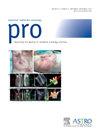Partially Ablative Body Radiation Therapy: A Widely Applicable Planning Technique for Palliation of Locally Advanced Unresectable Tumors
IF 3.5
3区 医学
Q2 ONCOLOGY
引用次数: 0
Abstract
Patients with locally advanced, bulky, and unresectable tumors frequently exhibit frailty and endure symptomatic burdens arising from the mass effect of their tumors. Conservative approaches may often fail to provide symptomatic benefits in relatively radioresistant, slower-growing tumors such as sarcomas. A novel technique termed partially ablative body radiation therapy (PABR) administers a highly centralized ablative dose through the utilization of a simultaneous integrated boost while delivering a low and safe palliative dose to the peripheral regions of tumors. The purpose of this paper was to describe a widely applicable radiation therapy protocol in detail for the PABR technique, of which clinical results are available in previous work.7 In summary, a PABR prescription of 20 Gy in 5 fractions is applied to the planning target volume and is planned for 95% of the volume to be covered by 95% of the prescribed dose. A dose of 50 Gy is planned to the boost target volume, with an allowed maximum dose of up to 65 to 70 Gy, using volumetric modulated arc therapy. Daily Cone-Beam Computed Tomography images are used for delivery verification and imaging study. The centrally located volume exceeding 50 Gy effectively achieved the desired outcomes of symptom relief and tumor size reduction. The PABR approach is widely accessible and can be readily implemented in a routine clinical setting to address a pressing need for the challenging palliative patient cohort.
部分烧蚀体放射治疗(PABR):广泛适用于姑息治疗局部晚期不可切除肿瘤的计划技术。
局部晚期、体积大和无法切除的肿瘤患者经常表现出虚弱,并承受着肿瘤肿块效应带来的症状负担。对于肉瘤等相对不耐受放射线、生长缓慢的肿瘤,保守疗法往往无法改善症状。一种被称为 "部分烧蚀体放射治疗"(PABR)的新技术通过利用同步综合增强(SIB)技术,在向肿瘤外围区域提供低剂量和安全的姑息剂量的同时,实施高度集中的烧蚀剂量。本文旨在详细描述一种广泛适用的 PABR 技术放射治疗方案,其临床结果可参见之前的研究7。总之,PABR 的处方剂量为 20Gy,分 5 次应用于 PTV,计划用处方剂量的 95% 覆盖 95% 的体积。利用容积调制弧疗法(VMAT),计划对增殖靶区施以 50Gy 的剂量,允许的最大剂量可达 65-70Gy。每日的 CBCT 图像用于剂量验证和成像研究。超过 50Gy 的中心剂量有效地达到了缓解症状和缩小肿瘤的预期效果。PABR 方法可广泛应用于常规临床治疗,以满足具有挑战性的姑息治疗患者群体的迫切需求。
本文章由计算机程序翻译,如有差异,请以英文原文为准。
求助全文
约1分钟内获得全文
求助全文
来源期刊

Practical Radiation Oncology
Medicine-Radiology, Nuclear Medicine and Imaging
CiteScore
5.20
自引率
6.10%
发文量
177
审稿时长
34 days
期刊介绍:
The overarching mission of Practical Radiation Oncology is to improve the quality of radiation oncology practice. PRO''s purpose is to document the state of current practice, providing background for those in training and continuing education for practitioners, through discussion and illustration of new techniques, evaluation of current practices, and publication of case reports. PRO strives to provide its readers content that emphasizes knowledge "with a purpose." The content of PRO includes:
Original articles focusing on patient safety, quality measurement, or quality improvement initiatives
Original articles focusing on imaging, contouring, target delineation, simulation, treatment planning, immobilization, organ motion, and other practical issues
ASTRO guidelines, position papers, and consensus statements
Essays that highlight enriching personal experiences in caring for cancer patients and their families.
 求助内容:
求助内容: 应助结果提醒方式:
应助结果提醒方式:


